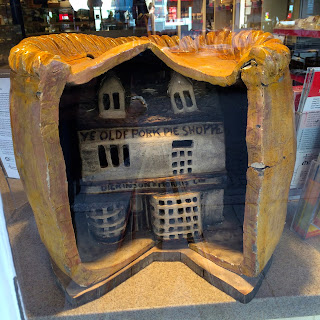"Is
it true they eat their first born?" asked a passenger to the bus driver
on the way to the rural capital of food – Melton Mowbray. I was on the no.19
bus from Nottingham and the pair were making banter about the driver being a
Melton local who enjoyed his job because it meant he could get away from the
place, whereas the passenger was buying a ticket to get there.
Melton was the original place where the town was 'painted red' by drunken revellers, and if you have any doubts about Melton's tourism credentials, then they should be confirmed by knowing that a very well known hotel chain has built somewhere for you to stay just a stone’s throw away from the cattle market.
The 'food capital' is Melton Mowbray's tourism tag and it was on Tuesday's market day
that I caught my bus there.
The
livestock market is an unusual experience to the outsider. The auction chant
and bidding is a bizarre and interesting form of communication to the outsider,
and all sorts of animals are sold here from small birds, to rabbits, chickens,
doves, turkeys, geese, sheep, calves and cattle.
If
you don't fancy going home with a crate of fowl then you can buy a Hambleton Bakery loaf or a piece of locally
made Stilton cheese. Melton is one of the few places in England where this
cheese is produced.
I
tried some of the latter when I had lunch at Miss B's cafe. While I was there I
overheard that this lovely place is going to close, but there's also a Miss B's
deli in town that's going to remain open, so I imagine they will be selling the
Stilton platter there too.
Dickinson
and Morris are the most well known pork pie makers here. Their shop is one of
the popular tourist stopping points. If you don't eat meat, go and look at the
pie shop sculpture in the front window.
Here
are some of the other interesting and quirky things you might see as you walk
around Melton Mowbray:
The
Regal Cinema: How great to see a local cinema still operating in a small town.
The inside is just as lovely as the outside and it has a very big screen.
The
bread ‘trap’ at Egerton Lodge residential home: This small opening was originally used to hand out pieces of bread to the poor. A plaque above the gate says
that it used to be part of a building which is ‘now’ occupied by Woolworths. I
think the sign needs updating…
I
found this sculpture in the memorial gardens outside Egerton Lodge:
Anne
of Cleves pub: So named because the building was 'gifted to Anne of Cleves by
Henry VIII as part of their divorce settlement' (from the pub’s website).
Better than a beheading I'll say...
One
thing you mustn't miss on your trip to Melton, however, is a visit to the
Carnegie Museum.
The
displays about the local cheese trade are interesting, but the most remarkable
exhibit is that of the ‘two-headed calf’.
Born in 1900 the ‘two calves in one skin’ didn't
live for long, but after taxidermy became a fund-raiser at Melton cattle market
for the Red Cross in both World Wars. You probably won't find any two-headed
calves at the livestock market today but you can buy a souvenir postcard of
Melton's most famous calf at the museum to send to your friends and relatives
back home...














































